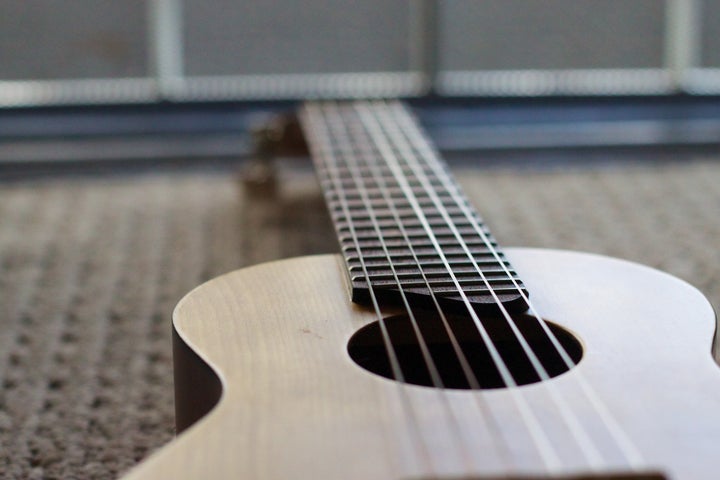
The guitalele, as its name implies, is a hybrid guitar-ukulele. It is far smaller and narrower than a standard acoustic guitar and substantially larger than a standard ukulele. I personally own the Yamaha GL1 Guitalele, fabricated in Indonesia. The instrument has thin frets and it is easy to play both rhythm and lead. As an avid traveler, I like the compact size of the guitalele. Unlike guitars with steel strings, the nylon strings will not rust quickly in countries with tropical climates such as Southeast Asia.
Like a guitar, the guitalele has six strings. The instrument is tuned in such a manner that chords and scales that you play on the guitar can be immediately applied to the guitalele. The one main difference is that the instrument must be tuned a 4th higher than the guitar. With this higher pitch, when you play chords strumming only the four higher pitched strings, the guitalele sounds quite similar to a ukulele. When you play all six strings, such as open guitar chords, the instrument has qualities more closely related to a guitar than ukulele.
However, since the tuning is a 4th higher, an open E chord will really be an A chord. A chord played as an open D with the transposition will actually be an F chord, and so on. When I play by myself, I still think of the open E formation as an E chord. However, the main potential drawback of the guitalele is evident when you perform with other musicians. If you see that other musicians are playing a song in the key of A, you cannot play an A chord, since the A is really a D chord. Therefore, you must play the E chord formation which is actually an A chord due to the tuning of the instrument a 4th higher. The same goes for playing guitar solos. If there is a blues jam in the key of E, you need to solo using the A blues scale.
You might be thinking, "Why not simply tune the guitalele to a standard guitar tuning when you play with others or want the instrument to sound more like a guitar?" Good idea. Unfortunately, the guitalele emits a rather dull sound quality and it is very hard to maintain a proper tuning when tuned down. Therefore, you are stuck with needing to transpose chords and leads when playing with others. I had to continually adjust my playing to the band I played with in Tulamben, Bali called T-Wreck. I would watch the rhythm guitar player and struggled to transpose the chords as well as where on the neck to solo. It was definitely a challenge, but I enjoyed performing with the group. In addition, the unique sound quality and aesthetic size of the guitalele made it appreciated by both the band and public alike.
Overall, I love the guitalele and recommend it to guitarists who do not wish to travel with a full-size guitar. The Yamaha guitalele is also reasonably priced, so if it were smashed during your travels, it wouldn't be devastating like losing your vintage Les Paul! It can be purchased second-hand for about $75 usd and new from $115-125 usd. The sound and size of the instrument are its primary advantages.
As I previously mentioned, very few nylon stringed instruments exist in this size category, an important factor in my decision to purchase the guitalele, as steel strings can rust very quickly in beach and tropical settings. When traveling, if you plan to simply practice by yourself, the guitalele would be perfect. If you will be playing with others, be sure to take into consideration what I mentioned in regard to the tuning and the potential impact and challenges that it may present when jamming with other musicians.
George Rajna, Co-founder of WeSaidGoTravel.com, MBA, MS Communications Disorders, is a bilingual speech therapist who has traveled to 100 countries across six continents. He composes music on the guitar and ukulele, and spent two years working in rural education for Peace Corps Paraguay. George recently took a career break for one year in Asia and is currently on an extended travel adventure in India with his wife, Lisa Niver Rajna. His favorite region is South East Asia and he recommends Bagan (Burma/Myanmar), Koh Lipe (Thailand/engagement), Angkor Temples (Cambodia), Langzong (China), diving in Sipandan (Malaysia), and trekking in Nepal.
Follow his year in South East Asia at: WeSaidGoTravel and on Facebook